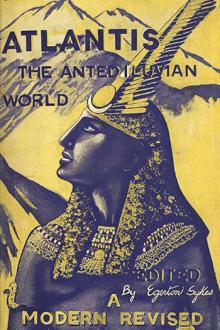Atlantis: The Antedeluvian World by Ignatius Donnelly (thriller novels to read .TXT) 📕

- Author: Ignatius Donnelly
- Performer: -
Book online «Atlantis: The Antedeluvian World by Ignatius Donnelly (thriller novels to read .TXT) 📕». Author Ignatius Donnelly
The same singular custom which is found among the Jews and the Hindoos, for “a man to raise up seed for his deceased brother by marrying his widow,” was found among the Central American nations. (Las Casas, MS.
“Hist. Apoloq.,” cap. ccxiii., ccxv. Torquemada, “Monarq. Ind.,” tom.
ii., 377-8.)
No one but the Jewish high-priest might enter the Holy of Holies. A similar custom obtained in Peru. Both ate the flesh of the sacrifices of atonement; both poured the blood of the sacrifice on the earth; they sprinkled it, they marked persons with it, they smeared it upon walls and stones. The Mexican temple, like the Jewish, faced the east. “As among the Jews the ark was a sort of portable temple, in which the Deity was supposed to be continually present, so among the Mexicans, the Cherokees, and the Indians of Michoacan and Honduras, an ark was held in the highest veneration, and was considered an object too sacred to be touched by any but the priests.” (Kingsborough, “Mex. Antiq., “vol.
viii., p.258.)
The Peruvians believed that the rainbow was a sign that the earth would not be again destroyed by a deluge. (Ibid., p. 25.) The Jewish custom of laying the sins of the people upon the head of an animal, and turning him out into the wilderness, had its counterpart among the Mexicans, who, to cure a fever, formed a dog of maize paste and left it by the roadside, saying the first passer-by would carry away the illness. (Dorman, “Prim. Super.,” p. 59.) Jacob’s ladder had its duplicate in the vine or tree of the Ojibbeways, which led from the earth to heaven, up and down which the spirits passed. (Ibid., p. 67.) Both Jews and Mexicans offered water to a stranger that be might wash his feet; both ate dust in token of humility; both anointed with oil; both sacrificed prisoners; both periodically separated the women, and both agreed in the strong and universal idea of uncleanness connected with that period.
Both believed in the occult power of water, and both practised baptism.
“Then the Mexican midwife gave the child to taste of the water, putting her moistened fingers in its mouth, and said, ‘Take this; by this thou hast to live on the earth, to grow and to flourish; through this we get all things that support existence on the earth; receive it.’ Then with moistened fingers she touched the breast of the child, and said, ‘Behold the pure water that washes and cleanses thy heart, that removes all filthiness; receive it: may the goddess see good to purify And cleanse thine heart.’ Then the midwife poured water upon the head of the child, saying, ‘O my grandson—my son—take this water of the Lord of the world, which is thy life, invigorating and refreshing, washing and cleansing. I pray that this celestial water, blue and light blue, may enter into thy body, and there live; I pray that it may destroy in thee and put away from thee all the things evil and adverse that were given thee before the beginning of the world. . . . Wheresoever thou art in this child, O thou hurtful thing, begone! leave it, put thyself apart; for now does it live anew, and anew is it born; now again is it purified and cleansed; now again is it shaped and engendered by our mother, the goddess of water.” (Bancroft’s “Native Races,” vol. iii., p. 372.) Here we find many resemblances to the Christian ordinance of baptism: the pouring of the water on the head, the putting of the fingers in the mouth, the touching of the breast, the new birth, and the washing away of the original sin. The Christian rite, we know, was not a Christian invention, but was borrowed from ancient times, from the great storehouse of Asiatic traditions and beliefs.
The Mexicans hung up the heads of their sacrificed enemies; this was also a Jewish custom:
“And the Lord said unto Moses, Take all the heads of the people, and hang them up before the Lord against the sun, that the fierce anger of the Lord may be turned away from Israel. And Moses said unto the judges of Israel, Slay ye every one his men that were joined unto Baal-peor.”
(Numb., xxv., 4, 5.)
The Scythians, Herodotus tells us, scalped their enemies, and carried the scalp at the pommel of their saddles; the Jews probably scalped their enemies:
“But God shall wound the head of his enemies, and the hairy scalp of such a one as goeth on still in his trespasses.” (Psa., lxviii., 21.) The ancient Scandinavians practised scalping. When Harold Harefoot seized his rival, Alfred, with six hundred followers, be “had them maimed, blinded, hamstrung, scalped, or embowelled.” (Taine’s “Hist.
Eng. Lit.,” p. 35.)
Herodotus describes the Scythian mode of taking the scalp: “He makes a cut round the head near the ears, and shakes the skull out.” This is precisely the Indian custom. “The more scalps a man has,” says Herodotus, “the more highly he is esteemed among them.”
The Indian scalp-lock is found on the Egyptian monuments as one of the characteristics of the Japhetic Libyans, who shaved all the head except one lock in the middle.
The Mantchoos of Tartary wear a scalp-lock, as do the modern Chinese.
Byron describes the heads of the dead Tartars under the walls of Corinth, devoured by the wild dogs:
“Crimson and green were the shawls of their wear, And each scalp had a single long tuft of hair, All the rest was shaven and bare.”These resemblances are so striking and so numerous that repeated attempts have been made to prove that the inhabitants of America are the descendants of the Jews; some have claimed that they represented “the lost tribes” of that people. But the Jews were never a maritime or emigrating people; they formed no colonies; and it is impossible to believe (as has been asserted) that they left their flocks and herds, marched across the whole face of Asia, took ships and sailed across the greatest of the oceans to a continent of the existence of which they had no knowledge.
If we seek the origin of these extraordinary coincidences in opinions and habits, we must go far back of the time of the lost tribes. We must seek it in the relationship of the Jews to the family of Noah, and in the identity of the Noachic race destroyed in the Deluge with the people of the drowned Atlantis.
Nor need it surprise us to find traditions perpetuated for thousands upon thousands of years, especially among a people having a religious priesthood.
The essence of religion is conservatism; little is invented; nothing perishes; change comes from without; and even when one religion is supplanted by another its gods live on as the demons of the new faith, or they pass into the folk-lore and fairy stories of the people. We see Votan, a hero in America, become the god Odin or Woden in Scandinavia; and when his worship as a god dies out Odin survives (as Dr. Dasent has proved) in the Wild Huntsman of the Hartz, and in the Robin Hood (Oodin) of popular legend. The Hellequin of France becomes the Harlequin of our pantomimes. William Tell never existed; he is a myth; a survival of the sun-god Apollo, Indra, who was worshipped on the altars of Atlantis.
“Nothing here but it doth change into something rich and strange.”The rite of circumcision dates back to the first days of Phœnicia, Egypt, and the Cushites. It, too, was probably an Atlantean custom, invented in the Stone Age. Tens of thousands of years have passed since the Stone Age; the ages of copper, bronze, and iron bare intervened; and yet to this day the Hebrew rabbi performs the ceremony of circumcision with a stone knife.
Frothingham says, speaking of St. Peter’s Cathedral, in Rome: “Into what depths of antiquity the ceremonies carried me back! To the mysteries of Eleusis; to the sacrificial rites of Phœnicia. The boys swung the censors as censors had been swung in the adoration of Bacchus.
The girdle and cassock of the priests came from Persia; the veil and tonsure were from Egypt; the alb and chasuble were prescribed by Numa Pompilius; the stole was borrowed from the official who used to throw it on the back of the victim that was to be sacrificed; the white surplice was the same as described by Juvenal and Ovid.”
Although it is evident that many thousands of years must have passed since the men who wrote in Sanscrit, in Northwestern India, could have dwelt in Europe, yet to this day they preserve among their ancient books maps and descriptions of the western coast of Europe, and even of England and Ireland; and we find among them a fuller knowledge of the vexed question of the sources of the Nile than was possessed by any nation in the world twenty-five years ago.
This perpetuation of forms and beliefs is illustrated in the fact that the formulas used in the Middle Ages in Europe to exorcise evil spirits were Assyrian words, imported probably thousands of years before from the magicians of Chaldea. When the European conjurer cried out to the demon, “Hilka, hilka, besha, besha,” he had no idea that he was repeating the very words of a people who had perished ages before, and that they signified Go away, go away, evil one, evil one. (Lenormant, “Anc. Hist. East,” vol. i., p. 448.)
Our circle of 360 degrees; the division of a chord of the circle equal to the radius into 60 equal parts, called degrees: the division of these into 60 minutes, of the minute into 60 seconds, and the second into 60
thirds; the division of the day into 24 hours, each hour into 60
minutes, each minute into 60 seconds; the division of the week into seven days, and the very order of the days—all have come down to us from the Chaldeo-Assyrians; and these things will probably be perpetuated among our posterity “to the last syllable of recorded time.”
We need not be surprised, therefore, to find the same legends and beliefs cropping out among the nations of Central America and the people of Israel. Nay, it should teach us to regard the Book of Genesis with increased veneration, as a relic dating from the most ancient days of man’s history on earth; its roots cross the great ocean; every line is valuable; a word, a letter, an accent may throw light upon the gravest problems of the birth of civilization.
The vital conviction which, during thousands of years, at all times pressed home upon the Israelites, was that they were a “chosen people,”
selected out of all the multitude of the





Comments (0)